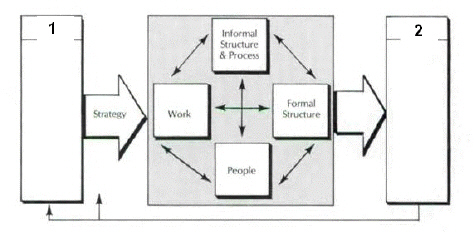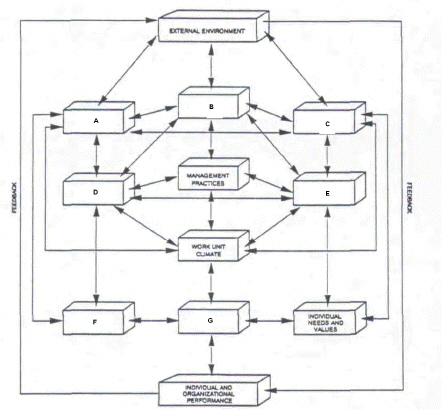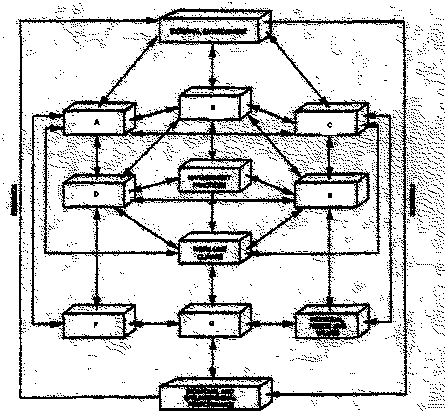Multiple Choice
Identify the
choice that best completes the statement or answers the question.
|
|
|
1.
|
Select the most true statement
a. | Strategic changes are less intense than incremental changes | b. | Intensity
relates to the type of the change | c. | Reactive changes are more intense than
anticipatory changes | d. | Organizations become less difficult to change
as they increase in size |
|
|
|
2.
|
Select the change variable that would typically be included in transformational
change
a. | Processes | c. | Technology | b. | Mission | d. | Products |
|
|
|
3.
|
Select the change variable that would typically be included in transactional
change
a. | People | c. | Goals | b. | Vision | d. | Culture |
|
|
|
4.
|
Select the option that does NOT refer to a change model
a. | Nadler & Tushman congruence model | d. | Porter’s five forces
model | b. | Sterman's systems dynamic model | e. | Greiner’s model | c. | Burke-Litwin
model |
|
|
|
5.
|
Select which model is described below: a causal model of transformational and transactional
organizational variables represented in an open system
a. | Nadler & Tushman congruence model | d. | Porter’s five forces
model | b. | Sterman's systems dynamic model | e. | Greiner’s model | c. | Burke-Litwin
model | f. | 7- S
model |
|
|
|
6.
|
Select which model which has its roots in organisational climate studies
a. | Nadler & Tushman congruence model | d. | Porter’s five forces
model | b. | Sterman's systems dynamic model | e. | Greiner’s model | c. | Burke-Litwin
model | f. | 7- S
model |
|
|
|
7.
|
Select which model is described below:
a model for organizational
analysis and dynamics including components such as strategy, structure, systems, etc
a. | Nadler & Tushman congruence model | d. | Porter’s five forces
model | b. | Sterman's systems dynamic model | e. | Greiner’s model | c. | Burke-Litwin
model | f. | 7- S
model |
|
|
|
8.
|
Select the option that is least correct when determining what constitutes
emergent (evolving) change
a. | Organisational change is typically achieved through a few radical
steps | b. | Change is a political-social process and not analytical-rational
one | c. | Organisational change is a continuous process of experimentation and
adaptation | d. | The role of managers is not to plan or implement change but to create or cultivate an
organisational structure and climate which encourages and sustains experimentation, learning and risk
taking, and to develop a workforce that will take responsibility for identifying the need for change
and implementing it |
|
|
|
9.
|
Which of the following is least likely to be used to describe an initial coping
response?
a. |
Acceptance |
c. |
Anger |
b. |
Depression |
d. |
Denial |
|
|
|
10.
|
 Consider the Nadler and Tushman (1989) change model shown
above - what is the correct label for item “1” in the diagram? a. | Environment | d. | Output | b. | Resources | e. | System | c. | Input | f. | Group
|
|
|
|
11.
|
 Consider the Nadler and Tushman (1989) change model shown
above - what is the correct label for item “2” in the diagram? a. | Environment | d. | Output | b. | Resources | e. | System | c. | Input | f. | Group
|
|
|
|
12.
|
Consider the model of organizational performance and change proposed by Burke
and Litwin (1992)  Identify the label for the box marked
“G” a. | Leadership | c. | Motivation | b. | Mission | d. | Culture |
|
|
|
13.
|
Consider the model of organizational performance and change proposed by Burke
and Litwin (1992)  Identify the label for the box marked
“F” a. | Leadership | d. | Culture | b. | Mission | e. | Skills | c. | Structure |
|
|
|
14.
|
Nadler and Tushman (1989) outlined Ten principles for large-scale
‘planned’ organizational reorientation
Select the item that is NOT one of those
principles
a. | Diagnosis | d. | Centrality | b. | Vision | e. | Magic Leader | c. | Energy
| f. | Change
agent |
|
|
|
15.
|
Consider implementing and managing change - identify the least true
statement
a. | Emergent change may be managed through the use of project management
tools and techniques | b. | Implementing the change involves translating
the change vision into specific actions undertaken by employees. | c. | There is a need to
mobilise commitment to change | d. | Measures are critical components of the control
system which guide the change and integrate the initiatives and efforts of various parties.
| e. | Change difficulty is determined by change type, complexity and resistance.
|
|